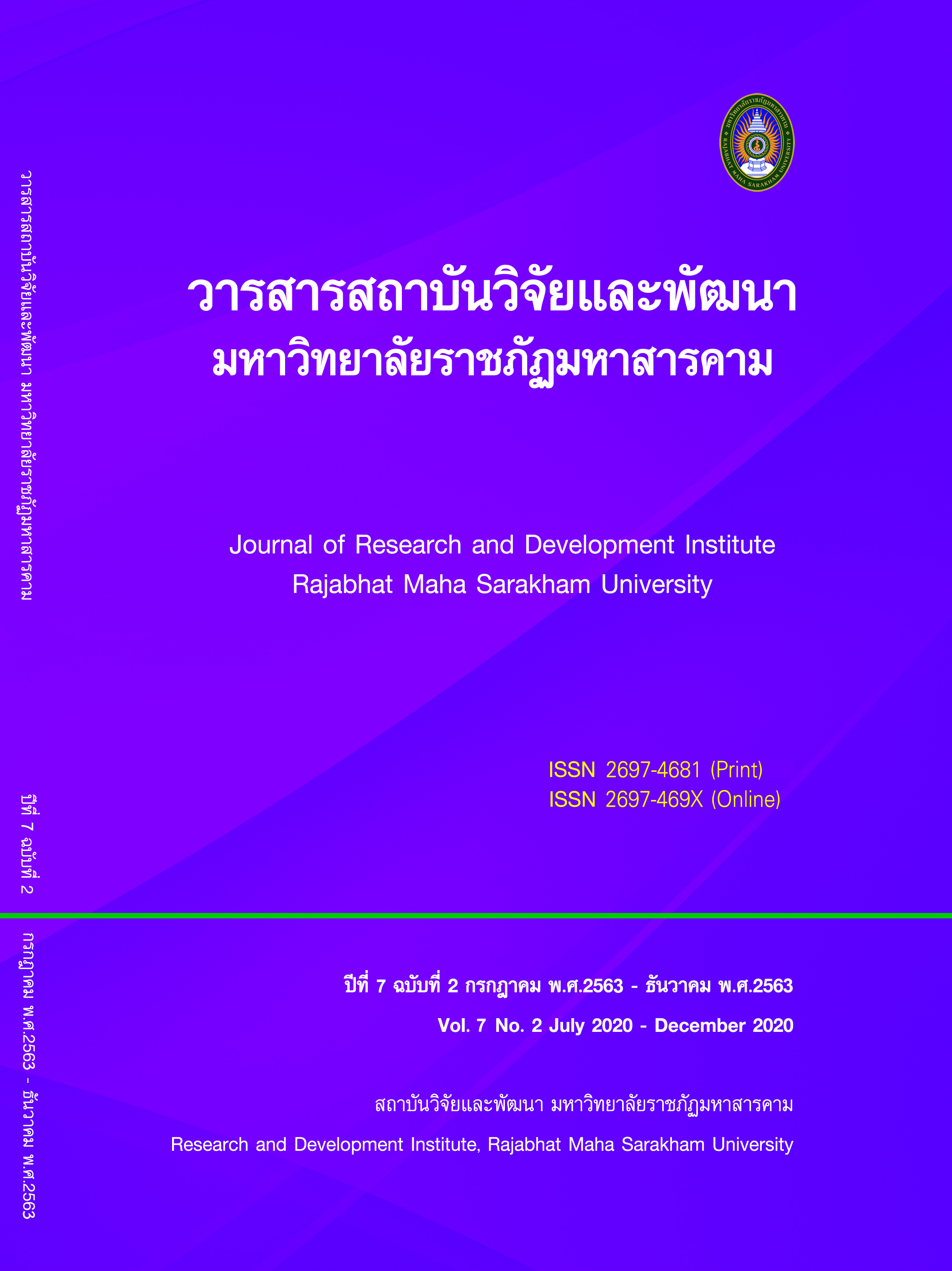Competitive Competency for Sustainable Organization of Automotive Services Entrepreneurs in Thailand
Keywords:
Competitive Capability, Sustainable Organization, Automotive Services EntrepreneursAbstract
The objectives of the research were 1) To study the composition of service quality factors. Entrepreneurial skills, Performance of working, Service Innovation, and Ability to compete with sustainability organizations 2) To study the relationships between factors that influence each other of service quality factors Entrepreneurial skills Performance of working, Service Innovation, and Competitiveness towards sustainability organizations. 3) To study the model of factors of competitiveness towards sustainability organizations. By conducting research in both quantitative and qualitative which quantitative is a simple sampling. The sample consisted of 480 supervisor level supervisors of automobile service centers in Thailand. The research tool was a questionnaire consisting of general questions and questions relating to initial variables. Which is an approximate scale pass the content accuracy test and confidence, and analyzed the data by using multiple regression analysis techniques for qualitative Use in-depth surveys In order to collect data from 9 automobile service center operators in order to study ways to improve the competitiveness of the organization of the sustainability of automobile service center operators in Thailand
The result of the research showed that model of Structural Equation factors were that influence the competitiveness of the organization of sustainability of automobile service center operators in Thailand. There were the model consistency index in harmony with the empirical data which can be considered at c2 = 247.36, df = 215, c2 / df = 1.151, P-value = 0.064, RMSEA = 0.018, GFI = 0.962, AGFI = 0.938 and the results of the structural equation model analysis on path influences affecting direct influence Performance Service Quality and Entrepreneurial skills effected directly influence the Service Innovation Statistical significance with the direct influence path coefficient equal to 0.581 ** 0.186 ** and 0.184 ** respectively and the Performance Service Quality, Entrepreneurial Skills effected indirectly influence through Service Innovation to Competitiveness towards a sustainable organization statistical significance with path coefficient of indirect influence is 0.158 ** 0.051 * and 0.050 * respectively. And the Performance Service Quality, Service Innovation, and Entrepreneurial Skills effected directly influence the ability to compete with sustainability organizations. With the direct influence coefficient equal to 0.357 ** 0.285 ** 0.271 ** and 0.093 * respectively. For guidelines for the development of competitiveness towards sustainability organizations, entrepreneurs provide guidelines for development that has to be given importance on Service Quality Enthusiasm of the area, having planning skills and targeting continuous learning Marketing Ability. Entrepreneurs must have patience, trying to strive for the organization to success. Attaching importance to the evaluation of the employees' job performance in changing positions at higher positions. Creating work motivation so that employees are willing to provide services to customers. Providing ongoing training for employees on the use of technology. The technology to be conveniently used with existing service methods more suitable in order to increase the efficiency and service potential. In summary, entrepreneurs agree that every variable is important to the competitiveness of the organization's sustainability of automobile service center operators in Thailand.
References
References
Charles W.L. Hill, G., Jones, R. (2009). Strategic management an integrated approach. New York: Dreamtech Press.
Davol, N.B., Mayor, M.G., & Luisa, M. & Hera, B.D. (2011). “Empirical analysis of technological innovation capacity and competitiveness in EU-15 countries”. African Journal of Business Management, 5 (14): 5753-5765
Department of Business Development. (2019). Automotive Maintenance Business: Business Analysis, Business Data Processing and Analysis Division, Business Information Division, Nonthaburi Province, June 2019. [Online] https://www.dbd.go.th/download/document_file/Statisic/2562/T26/T26_201906.pdf
Department of Land Transport, Bureau of Transportation Systems. (2019). Land transport statistics. [Online] http://apps.dlt.go.th/statsitics.html.
Hair, J., Anderson, R., Tatham, R., Black, W. (1998). Multivariate data analysis. 5th ed. New Jersey: Prentice Hall,
Hunt, B. & Virasa, T. (2009). “Generation Y: An emerging entrepreneurial phenomenon”. Paper presented at the meeting of the 6th Annual AGSE International Entrepreneurship Research Exchange. Stuttgart, Germany.
Kamonkan Theptaranonth. (2005). The relationship among Leadership, Intrinsic Motivation, Charateristics of Entrepreneurs and Business Success of Small and Medium Enterprises. Bangkok: Kasetsart University.
Miller, D. (1983). “The correlates of entrepreneurship in three types of firms”. Management Science, 29(7): 770-791.
National Innovation Agency. (2015). THE ELECTRIC PLAYGROUND. [Online] http://www.nia.or.th/spring/ index.php?page=faq. [25 August 2015]
Nawarat Wimutta (2014). Service quality of the Toyota Service Center, Pathum Thani. Master of Business Administration Thesis: Valaya Alongkorn Rajabhat University under the Royal Patronage of His Majesty the King
Panithan Leenakitti. (2015). THE DEVELOPMENT GUIDELINES FOR SUSTAINABLE ORGANIZATION ACCORDING TO 2020 STRATEGY OF CPF (THAILAND) CO., LTD. Master of Business Administration Program (Global Business Management): Burapha University.
Parasuraman A., Zeithaml V., & Berry, L. (1990). Delivering quality service: balancing Customer perceptions. New York: The Free Press.
Parasuraman, A., Grewal, D. (2000). “The impact of technology on the quality-value-loyalty chain: a research agenda”. Journal of the Academy of Marketing Science, 28(1): 168-174.
Phichaya Wattanarungsun. (2015). Increasing performance efficiency of employees in 4-star hotels in Siam Square. Master of Independent Research (Hospitality and Tourism Industry Management): Bangkok University.
Schumacker, E.R., & Lomax, G.R. (1996). A beginner’s guide to structural equation modeling. Mahwah, NJ: Erlbaum.
Sorasak Kwoalueng. (2015). Factors Agility on the Competitive Advantage in Construction Firm. Business Administration and Economics Review, 12 (1), 162-181.
Supparerk Pothipairatana. (2010). Corporate image indicators. Doctor of Communication Arts thesis (Communication Arts): Chulalongkorn University.
Suwit Inkhean. (2016). Strategies related to business success of machinery firms in Samut Prakan province. Master of Business Administration (Business Engineering Management): Rajamangala University of Technology Thanyaburi.
Van Marrewijk, M., & Hardjono, T.W. (2003). “European corporate sustainability framework for managing complexity and corporate transformation”. Journal of Business Ethics, 44 (2-3): 121-132.
Vichit Uon. (2010). Research and business information discovery. Bangkok: Sripatum University Press.
Walailak Rattanawong, Nuttida Suwanno and Teerasak Jindabot . (2014). “Innovation in service and its measurement in Thailand's tourism business: Small and medium enterprises”. Journal of Management Sciences, 31 (1), 119-146.
Weng, M.H., Ha, J.L., Wang, Y.C. & Tsai, C.L. (2012). “A Study of the relationship among Service innovation customer value and customer satisfaction: an industry in Taiwan”. International Journal of Organizational Innovation, 4(3): 98-112.
Zale, N. (1985). Creating a culture of competence. New York: John Wiley and Son.
Zeithaml, V.A., Parasuraman, & Berry, L.L. (1990). Delivering quality Service: Balancing customer perceptions. New York: The Free Press.
Downloads
Published
How to Cite
Issue
Section
License
Articles that are published are copyrighted by the authors of the articles






